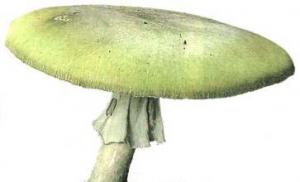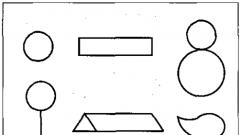Worms. Type Flatworms - Plathelminthes
hallmark flatworms- flattened body in the dorsal-abdominal direction. Unlike coelenterates, in flatworms between ectoderm and endoderm(outer and inner layer of cells) is the third layer of cells - mesoderm. Therefore, they are called three-layer animals that do not have a body cavity (it is filled parenchyma- a loose cell mass in which internal organs are placed).
The symmetry of the body is bilateral. There are over 12,000 species in the type. The type of flatworms is divided into classes: ciliary, flukes, tape worms.
Class ciliary worms
Eyelash worms live in the seas, fresh waters and wet soil. They feed mainly on small animals. Their body is covered with cilia, with which they move. One of the representatives is white planaria.
At the front end of the body, two lateral outgrowths (organs of touch) are visible. Next to them are two eyes, with the help of which the planarian distinguishes light. Planaria is a predator. Her pharynx is a trapping apparatus that protrudes out through the mouth, located on the ventral side, penetrates into the prey and sucks out its contents. Digestion of food takes place in the branched intestine. Undigested residues are thrown out through the mouth. The planarian breathes with the entire surface of the body. The excretory organs consist of a system of branched tubules located on the sides of the body. Liquid harmful metabolic products are excreted through the excretory pores.

Nerve cells are assembled into two nerve trunks, which are connected by thin bridges. At the anterior end of the body, they form a thickening - ganglion, from which to the sense organs (eyes and organs of touch) and to the rear end of the body depart nerve processes.
Reproductive organs - two oval ovaries and numerous testes, develop in the body of one individual and form germ cells - eggs and spermatozoa. Animals that have both female and male reproductive organs are called hermaphrodites. Their fertilization is internal, cross, after which the planaria lays cocoons with eggs. Her development is direct.
fluke class

Once in the water, microscopic larvae equipped with cilia develop from the eggs. They are introduced into the body of the mollusc of a small pond snail, in which they grow, multiply, and tail larvae appear. These larvae leave the mollusk, actively swim in the water, then attach themselves to plants, discard their tail, become covered with a thick shell - a cyst is formed. With grass or water, the cyst enters the intestines of the cow, where an adult worm develops from it. A person can become infected with a liver fluke if he drinks water from a dirty reservoir.
class of tapeworms

Tapeworms - almost all hermaphrodites, are characterized by high fecundity and development with a change of hosts. Each segment of the bull tapeworm has one ovary and many testes. The eggs mature in the oldest, posterior segments, which break off and come out with feces. Further development of the eggs will occur if, together with the grass, they are swallowed by cattle. In the stomach of a cow, larvae emerge from the egg, which, by perforating the walls of the intestine, enter the bloodstream.

FLAT WORMS
The organ systems of flatworms are represented by the digestive, nervous, excretory, and reproductive systems. The digestive system is closed. The nervous system consists of a paired head node and two lateral trunks extending from it, which stretch along the body with peripheral branches. Free-living forms have developed light-sensitive eyes, olfactory cells, and organs of balance.
The types of flatworms include classes:
1. Eyelash worms
2. Flukes
3. Tapeworms
Class ciliary worms
The class ciliary worms includes free-living marine or freshwater, rarely terrestrial worms, the entire body of which is covered with ciliated epithelium. Under the epithelium are layers of smooth muscles that run in different directions. The movement of the worms is provided by the work of the cilia and the contraction of the muscles. Many species are characterized by regeneration.
Typical representative - white planaria. It lives in fresh stagnant water bodies on underwater objects and plants. Its flat body is elongated. At the anterior end, two small tactile tentacle-like outgrowths and two eyes are visible.
The nervous system consists of clusters of nerve cells - the head ganglion. Nerve trunks depart from it to the sense organs - the eyes and the organs of touch (lateral outgrowths).
Planaria is a predatory animal. Her mouth is located on the ventral side, almost in the middle of the body. With the help of a muscular pharynx protruding outward, the planaria penetrates into the prey and sucks out its contents. The digestive system is closed blindly, so the mouth opening serves to throw out undigested residues. Digestion of food is carried out intracellularly (phagocytosis - the capture of food particles with the help of pseudopods) and extracellularly due to enzymes that are secreted by glands located in the pharynx and intestinal walls. Phagocytosis was discovered by Ilya Ilyich Mechnikov in 1865.
Breathing is carried out by the entire surface of the body. There is no circulatory system. The selection system appears.
The organs of excretion - protonephridia, are located on the sides of the body.
Reproduction:
Reproduction of planarians can occur asexually. Asexual reproduction is carried out by the transverse division of the body into two parts. The division begins with a transverse constriction of the body behind the pharynx. Each half regenerates missing body parts. The reproductive system of ciliary worms is hermaphroditic; cross fertilization. Small planarians develop in the cocoon.
fluke class
2. A variety of attachment organs to the host body (suckers, hooks, etc.)
3. Regressive development of the nervous system and sensory organs.
4. Simply arranged digestive system or its absence.
5. Extremely high fertility.
A typical representative of the class -liver fluke. It lives in the adult state in the bile ducts of the liver, in the gallbladder of herbivores and in humans. Feeds on bile and blood, causes diseasefascioliasis.
The body shape is leaf-shaped. With the help of suction cups, it is held in the body of the host. The dermal-muscular sac consists of an epithelium devoid of cilia and three layers of muscles. The digestive system is represented by a mouth located at the front end of the body, a muscular pharynx, esophagus and a branched intestine. Excretory system of protonephridial type. The nervous system consists of the peripharyngeal nerve ring and three pairs of nerve trunks extending from it, interconnected by bridges. The sense organs are poorly developed.
Life cycle of the liver fluke

class of tapeworms
Tapeworms are hermaphrodites. Immature segments are located in the anterior part of the body, in the middle - hermaphroditic, at the end - mature.
Life cycle of bull tapeworm

Meat containing viable Finns that has not passed a veterinary examination serves as a source of human infection: when eating uncooked or undercooked, as well as raw beef. In the human intestine, the shell of the Finn dissolves, the head of the young worm turns out and, with the help of suction cups, is attached to the mucous membrane of the small intestine. Mature segments with eggs are obtained from a sexually mature individual.
All worms can be divided into three types (flat, ringed, round), each of which has its own characteristic features. This type refers to invertebrates lacking a body cavity and possessing bilateral symmetry.
Patients who want to get rid of worms often ask for natural remedies with the least side effects. In such cases, I recommend this tool.
The main signs of the type of flatworms
- digestive;
- nervous;
- sexual;
- excretory.
This type has the presence of several systems and even the rudiments of organs
Circulatory system
Not available, but the function of the blood is performed by the parenchyma, consisting of connective cells. It is she who transports nutrients in the body.
Digestive system
Rather simplified, it consists of a pharynx and intestines.
The pharynx is powerful, can:
- suck;
- twist and wrap around your prey.
The intestine consists of two sections - anterior and middle, most often branched. It has a closed structure, so that all undigested waste exits through the mouth. The mouth opening is located closer to the middle of the body of the worm.
Free worms are mostly predators and they even have a kind of adaptation for capturing prey. This system is not observed in all classes; more primitive worms do not have it. For example, tapeworms feed on the entire surface.
excretory system
The excretory system is quite large and consists of many tubules that combine and lead to the excretory pores.
The parenchyma contains special cells that drive harmful substances into the tubules. For humans, these excretory products are very dangerous and toxic along with poison.
(Protostomia). Representatives of the class of ciliary worms live in salt and fresh waters, some species have adapted to life in wet terrestrial habitats. Representatives of other classes lead an exclusively parasitic way of life, parasitizing on various animals, both vertebrates and invertebrates. Currently, about 25,000 species are described, in Russia - more than 3,000 species.
Encyclopedic YouTube
-
1 / 5
The body is bilaterally symmetrical, with clearly defined head and tail ends, somewhat flattened in the dorsoventral direction, in large representatives it is strongly flattened. The body cavity is not developed (with the exception of some phases of the life cycle of tapeworms and flukes). The exchange of gases is carried out through the entire surface of the body; respiratory organs and blood vessels are absent.
body integuments
Outside, the body is covered with a single-layered epithelium. In ciliary worms, or turbellaria, the epithelium consists of cells that carry cilia. Flukes, monogeneans, cestodes, and tapeworms lack ciliated epithelium for most of their lives (although ciliated cells may occur in larval forms); their covers are represented by the so-called tegument, in a number of groups bearing microvilli or chitinous hooks. Tegumented flatworms belong to the Neodermata group. Flatworms can regenerate 6/7 of their body.
musculature
Under the epithelium there is a muscular sac, consisting of several layers of muscle cells that are not differentiated into individual muscles (a certain differentiation is observed only in the region of the pharynx and genital organs). The cells of the outer muscle layer are oriented across, the inner - along the anterior-posterior axis of the body. The outer layer is called the layer of circular muscles, and the inner layer is called the layer of longitudinal muscles.
Throat and intestine
In all groups, except for cestodes and tapeworms, there is a pharynx leading to the intestine or, as in the so-called non-intestinal turbellaria, to the digestive parenchyma. The intestine is blindly closed and communicates with the environment only through the mouth opening. Several large turbellarians have anal pores (sometimes several), but this is the exception rather than the rule. In small forms, the intestines are straight, in large ones (planarians, flukes) it can branch strongly. The pharynx is located on the abdominal surface, often in the middle or closer to the posterior end of the body, in some groups it is shifted forward. Cestode and tapeworms do not have a gut.
Nervous system and sense organs
The nervous system is represented by nerve nodes located in the anterior part of the body of the worm, brain ganglia and nerve columns extending from them, connected by jumpers. The sense organs, as a rule, are represented by separate skin cilia - processes of sensitive nerve cells. Some free-living representatives of the type, in the process of adapting to living conditions, acquired light-sensitive pigmented eyes - primitive organs of vision and organs of balance.
Nephridia and accumulation kidneys
Osmoregulation is carried out with the help of protonephridia - branching canals that connect into one or two excretory canals. The release of toxic metabolic products occurs either with the fluid excreted through protonephridia, or by accumulation in specialized parenchyma cells (atrocytes), which play the role of "accumulation kidneys".
The body cavity is absent, the space inside the skin-muscle sac between the internal organs is filled with a loose mass of connective tissue cells - the parenchyma. Tissue fluid circulates between cells
The nervous system consists of a paired head ganglion and several nerve trunks extending from it. These trunks are connected to each other by transverse nerve cords (commissures). The sense organs are most well developed in free-living ciliary worms, which have balance organs - statocysts. The eyes, unlike the eyes of jellyfish, are of an inverted type. All flatworms have receptors for the perception of mechanical and chemical stimuli.
The digestive system is present in turbellaria and flukes, it consists of two sections: anterior (ectodermal) and middle (endodermal). The intestine is blindly closed, there is no hindgut and anus. Cestodes do not have a digestive system.
Scheme of the structure of protonephridia:
1 - excretory canal,
2 - branching of the tubules,
3 - cirtocytes ("stellate cells"),
4 - cilia ("flickering flame").The excretory system is represented by individual cells of the parenchyma (atrocytes) and protonephridia. Protonephridia are of ectodermal origin and represent a system of branching canals that remove waste products from the body in dissolved form (see Fig.). From the side of the body cavity, the tubules are closed by cytocytes. Cyrtocyte - a large star-shaped cell with a bunch of cilia ("flickering flame"). The beating of cilia ensures the outflow of intercellular fluid from the parenchyma into the protonephridial tubule. The tubules flow into one or two excretory canals, which open outwards with excretory pores. Accumulation of waste products occurs in atrocytes.
The circulatory system is absent.
Flatworms are hermaphrodites. The reproductive system, in addition to the testes and ovaries, includes adnexal formations that ensure the fertilization process, supply the eggs with the necessary nutrients and create protective shells around the egg. The development of flatworms takes place in most cases with metamorphosis, through a series of larval stages.
Type Flatworms are divided into classes: 1) Ciliary worms (Turbellaria), 2) Flukes (Trematoda), 3) Tapeworms (Cestoda), etc.













